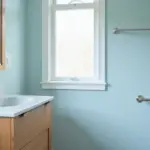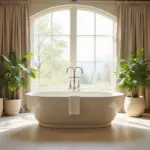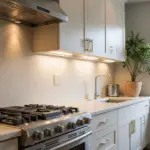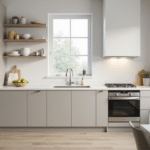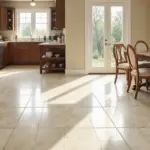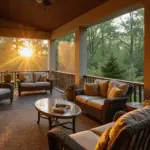Your backyard should be more than just open space—it should be a sanctuary where design meets tranquility. A patio pergola stands at this intersection, offering both architectural beauty and functional shade while defining your outdoor living area with intentional design.
The beauty of a pergola lies in its balance of openness and structure—much like the principles of zen design. It creates a defined space without walls, allowing energy to flow freely while providing a framework for relaxation and connection with nature.
Here’s where it gets interesting: a well-designed patio pergola doesn’t just transform your space physically—it changes how you experience your home entirely.
The Essence of Patio Pergola Design
A patio pergola serves as both practical shelter and artistic statement. At its core, this structure provides welcome shade from harsh sunlight while defining a distinct outdoor living area. Beyond functionality, it adds architectural interest that elevates your property’s visual appeal and value.

What makes pergolas particularly special is their versatility. They create dedicated zones for everything from morning meditation to evening gatherings, all while supporting climbing plants that add natural beauty and privacy. This combination of purpose and aesthetics makes them uniquely valuable in mindful outdoor design.
The heart of the matter is finding the right balance between form and function—something that resonates deeply with both zen principles and modern design sensibilities.
The Cooling Sanctuary: Shade Benefits
Picture this: it’s midsummer, the sun blazes overhead, but beneath your patio pergola, you sit comfortably enjoying the outdoors. This isn’t just pleasant—it’s practical. The lattice structure of a pergola works brilliantly by filtering sunlight rather than blocking it completely, creating a microclimate that’s significantly cooler.

Studies show that well-designed shade structures can reduce ambient temperatures by 10-20 degrees Fahrenheit. This natural cooling effect transforms previously unusable hot patios into comfortable retreats, extending your outdoor living season considerably. For enhanced shade, consider:
- Training climbing vines to create a living canopy
- Adding bamboo or fabric panels between beams
- Installing a retractable canopy for adjustable coverage
The missing piece in many outdoor spaces is this thoughtful approach to managing sunlight—creating areas that respect both our need for light and our desire for comfort.
Creating a Mindful Retreat
The true potential of a patio pergola emerges when you approach it as a dedicated space for mindfulness and relaxation. This isn’t just furniture under a structure—it’s about crafting an environment that calms the senses and encourages presence.
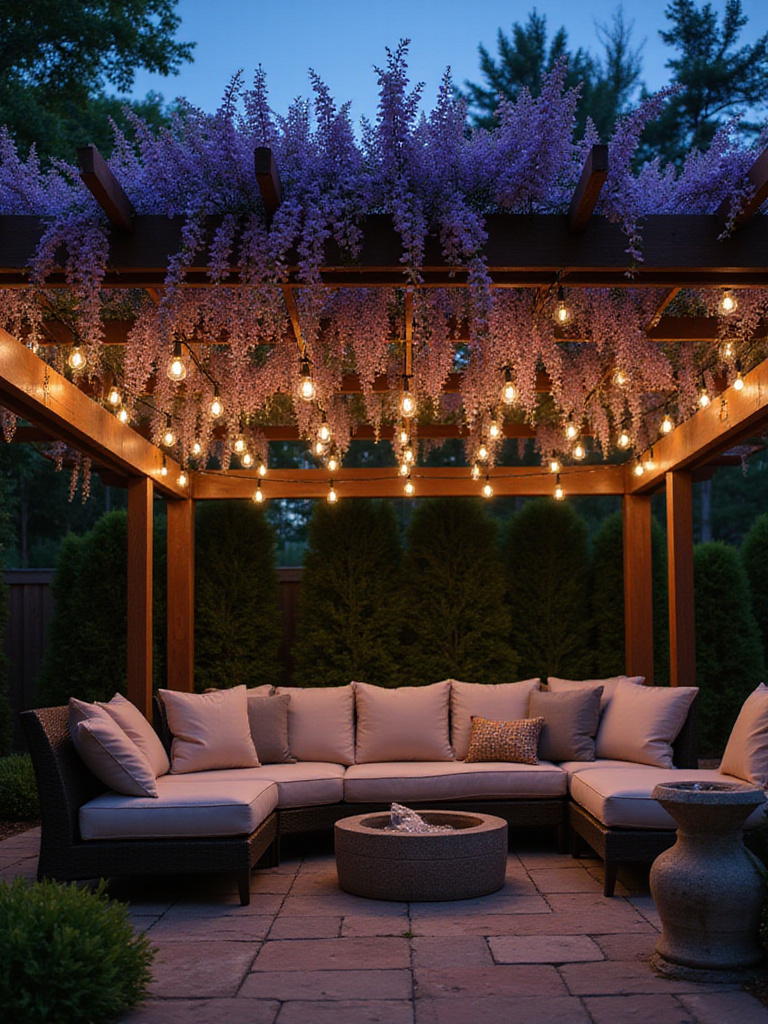
Begin with comfortable seating that invites lingering—deep cushions, natural materials, perhaps even a hanging chair that gently sways. Add soft lighting with paper lanterns or string lights for evening ambiance. Consider incorporating elements that engage multiple senses: the sound of wind chimes, the scent of jasmine climbing the posts, the texture of natural wood overhead.
Let that sink in for a moment—your patio pergola can become more than a structure; it can be a dedicated space for reconnecting with yourself and nature in our increasingly digital world.
Bridging Indoor and Outdoor Living
One of the most powerful aspects of a patio pergola is how it creates a seamless transition between your interior and exterior spaces. Unlike fully enclosed structures, a pergola maintains openness while providing enough definition to feel like an outdoor room—a perfect expression of the zen principle of balanced boundaries.
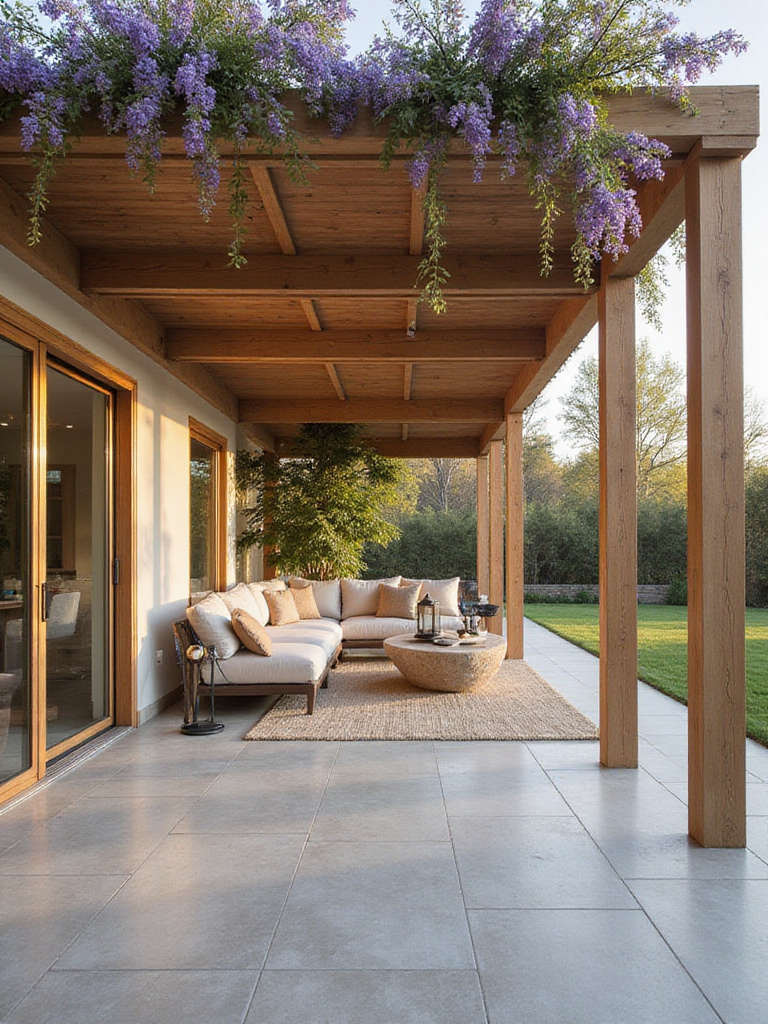
This architectural bridge works by creating a visual and physical threshold that guides movement between spaces. When aligned with doors or windows, your patio pergola becomes a natural extension of your home, encouraging a more fluid relationship with your outdoor environment. This connection is particularly valuable in smaller homes, effectively expanding your living space without walls.
Looking beneath the surface, this integration reflects a deeper philosophy about how we inhabit spaces—recognizing that true harmony comes from blending rather than separating our indoor and outdoor experiences.
Enhancing Property Aesthetics
A thoughtfully designed patio pergola instantly transforms your property’s visual appeal. Unlike temporary fixtures, a pergola adds architectural character and permanent value that potential buyers recognize and appreciate. It creates a focal point that draws the eye and suggests an intentional approach to outdoor living.

The key to maximizing this aesthetic impact lies in choosing a design that complements your home’s existing architecture. For contemporary homes, clean lines and minimalist structures create harmony. For traditional properties, more ornate details and classic proportions maintain visual coherence. In either case, the pergola should feel like it belongs—as if it were always part of the original design vision.
“The best designs don’t shout for attention—they simply feel right, as though the space would be incomplete without them.” – Kai Nakamura
Material Considerations: Wood vs. Metal
The materials you choose for your patio pergola profoundly influence both its appearance and longevity. This decision deserves careful consideration, as it shapes not only aesthetics but also maintenance requirements for years to come.

Wood pergolas offer natural warmth and organic beauty that’s difficult to replicate. Cedar, redwood, and teak naturally resist decay and insects, developing a silvery patina over time that many find appealing. However, they require regular maintenance—annual cleaning and sealing—to preserve their integrity. Metal pergolas, particularly aluminum and steel, provide exceptional durability with minimal upkeep. They offer cleaner lines that complement modern architecture and can support heavier climbing plants without concern for structural integrity.
Digging deeper into this decision reveals an interesting parallel with zen philosophy—finding balance between natural elements and modern practicality, between aesthetic pleasure and functional simplicity.
Finding Your Design Style
The design spectrum for patio pergolas ranges from rustic charm to sleek modernism, with countless variations between. Your choice should reflect both your home’s architecture and your personal aesthetic sensibilities.

Rustic pergolas embrace natural materials and organic imperfections. Think rough-hewn timber, visible joinery, and perhaps stone elements. These designs create a sense of warmth and connection to traditional craftsmanship. At the opposite end, modern pergolas feature clean lines, precise angles, and often incorporate materials like metal, glass, and composite materials. They create a sense of sophisticated simplicity that complements contemporary architecture.
The plot thickens when you consider hybrid approaches—perhaps a clean-lined structure built from reclaimed wood, or a traditional design executed with modern materials. These creative intersections often yield the most interesting and personally meaningful results.
DIY or Professional Installation?
The question of whether to build your patio pergola yourself or hire professionals depends on several factors: your skill level, available time, design complexity, and budget considerations.

DIY pergola projects can be deeply satisfying and cost-effective if you have carpentry experience and proper tools. Pre-cut kits simplify the process considerably, providing materials and instructions while still allowing the satisfaction of personal creation. However, more complex designs, especially those requiring concrete footings or electrical wiring, often benefit from professional expertise. Professionals also ensure structural integrity and code compliance, which provides peace of mind.
When we look at this from another angle, the choice also reflects your relationship with the space—some find deeper connection through the act of building, while others prefer to focus their energy on how they’ll use and enjoy the finished structure.
Living Canopy: Plants and Vines
Transform your patio pergola into a living structure by integrating carefully selected climbing plants. This natural approach to pergola enhancement creates a dynamic space that changes with the seasons while providing additional shade and habitat for beneficial insects.

For sunny locations, consider wisteria for its dramatic cascading flowers, climbing roses for romantic appeal, or grape vines for both beauty and function. In shadier spots, climbing hydrangea, Virginia creeper, or jasmine offer lush foliage and, in some cases, delightful fragrance. Training these plants requires patience—use soft ties to guide young stems along the structure without restricting growth, and prune regularly to maintain the desired shape and density.
The ripple effects of introducing plants to your pergola extend beyond aesthetics—they create a microclimate that cools the area, improve air quality, and foster a deeper connection between your built environment and the natural world.
Evening Ambiance: Lighting Design
As daylight fades, thoughtful lighting transforms your patio pergola into an enchanting evening retreat. The right illumination extends usability while creating atmosphere—an essential consideration for truly functional outdoor living.

Consider layering different light sources for greatest effect. String lights woven through the pergola beams create overall ambient illumination. Downlights mounted discreetly on the structure highlight seating areas and dining spaces. Solar-powered accent lights along pathways guide movement. For special versatility, install dimmer switches that allow you to adjust brightness according to the occasion—brighter for gatherings, softer for quiet evenings alone.
The missing piece in many outdoor lighting plans is intentionality—moving beyond basic illumination to consider how light shapes mood and directs attention, creating a space that feels magical after sunset.
Enhancing Sun Protection
While the slatted roof of a traditional patio pergola provides filtered shade, sometimes you need additional protection from intense sunlight or unexpected rain. Thoughtfully enhancing your pergola’s coverage creates a more versatile outdoor space you can enjoy in varied conditions.

Consider these practical enhancements:
- Retractable canopies that deploy when needed
- Weather-resistant fabric panels woven between beams
- Louvered roof systems with adjustable slats
- Natural coverage from trained vines and climbers
- Bamboo roll-up shades for side protection
The breakthrough came when designers realized these functional elements could also become aesthetic features—the shadows cast by a fabric panel, the geometric pattern of a louvered roof, or the dappled light through vine-covered beams all contribute to the sensory experience of the space.
Furnishing Your Pergola Space
Selecting furniture for your patio pergola requires balancing durability, comfort, and design coherence. The right pieces transform your structure from architectural feature to functional living space while expressing your personal style.

Weather-resistant materials are essential—teak, aluminum, and high-quality synthetic wicker withstand the elements while maintaining their appearance. Arrangement matters too; consider how people will move through the space and interact with each other. A conversation set with chairs facing inward creates intimacy, while a dining table with benches encourages communal meals. Add weather-resistant cushions and throws in colors that complement your home and garden for both comfort and visual harmony.
Looking beneath the surface, your furniture choices reveal much about how you intend to use the space—for quiet contemplation, social gathering, outdoor dining, or perhaps all three at different times.
Maintenance Simplicity
A beautiful patio pergola deserves care that preserves its appeal without becoming burdensome. Simple, regular maintenance prevents more significant issues and keeps your outdoor sanctuary looking its best year after year.

For wooden pergolas, inspect annually for signs of water damage, insect activity, or splitting. Clean with mild soap and water, avoiding pressure washers that can damage the wood grain. Apply a quality sealant every 1-2 years, depending on your climate. Metal pergolas require checking for rust spots or paint chips, which should be promptly treated to prevent spreading. Clean with appropriate metal cleaners and check that all connections remain secure.
The game-changer happened when I realized that maintenance isn’t just about preservation—it’s an opportunity to reconnect with your space, noticing small changes and addressing them before they become problems.
Budget Considerations
Creating your dream patio pergola requires thoughtful financial planning. Understanding cost factors helps you make informed decisions that balance quality, aesthetics, and budget reality.

Material choice significantly impacts cost—pressure-treated pine offers affordability ($1,500-$3,000 for a basic structure), while cedar or redwood increases durability and visual appeal at higher price points ($4,000-$10,000). Size and complexity naturally affect material quantities and labor requirements. Custom designs with special features like built-in lighting, retractable canopies, or architectural details can push costs toward the upper range ($8,000-$20,000+). For budget-conscious projects, consider:
- Simplified designs with fewer decorative elements
- Phased building approach—basic structure now, enhancements later
- DIY installation with pre-cut kits
- Standard sizes rather than custom dimensions
What complicates this is balancing immediate cost savings against long-term value—sometimes investing more initially in quality materials reduces lifetime maintenance costs and increases property value.
Pergola vs. Gazebo: Making the Choice
When considering outdoor structures, many homeowners debate between patio pergolas and gazebos. Understanding their fundamental differences helps you select the option that best suits your needs and space.

Pergolas feature open lattice roofs that provide filtered light and partial shade, creating an airy feeling that maintains connection with the surrounding landscape. Their design emphasizes vertical definition without complete enclosure. Gazebos, conversely, offer fully covered roofs for complete weather protection, often with a raised floor and sometimes partial walls. They create a more defined “room” separate from the landscape. Pergolas typically cost less, offer more design flexibility, and integrate more naturally with gardens, while gazebos provide better weather protection and a more distinct outdoor room.
The key thing to understand is that this choice reflects different philosophies about outdoor living—pergolas blur the boundary between architecture and landscape, while gazebos create a more defined separation between the two.
Attached or Freestanding Design
The relationship between your patio pergola and your home’s structure presents another important design decision. Both attached and freestanding designs offer distinct advantages that influence how the space functions and feels.

Attached pergolas connect directly to your home’s exterior wall, creating a natural extension of your indoor space. This design saves space by eliminating one row of support posts and often costs less to build. It creates a seamless transition from indoors to outdoors—particularly effective when aligned with doors or windows. Freestanding pergolas offer greater placement flexibility, allowing you to create a destination point anywhere in your yard. They can define a space away from the house, perhaps near a garden feature or to take advantage of a view, and their four-sided support structure often allows for more elaborate roof designs.
When we look beneath the surface, this choice reflects how you conceptualize your outdoor living—as an extension of your home or as a separate retreat within your landscape.
Fire Features and Pergolas
Incorporating a fire feature beneath your patio pergola creates a captivating focal point that extends outdoor enjoyment into cooler seasons. This combination of elements speaks to something primal in us—the attraction to sheltered space and warming fire.

Safety considerations must come first. Ensure adequate clearance between the fire feature and pergola ceiling—generally at least 6-10 feet for wood-burning features, potentially less for gas models that produce less heat and smoke. Choose appropriate materials for nearby pergola elements, avoiding anything highly flammable. Gas fire pits and tables offer the most control and produce less smoke, making them ideal for pergola integration. Arrange seating to balance proximity to the fire with conversation flow, creating a space that feels both intimate and comfortable.
The breakthrough came when designers realized that the partial enclosure of a pergola actually enhances the fire experience—providing just enough shelter to block wind while maintaining openness that prevents smoke buildup, creating the perfect balance for year-round enjoyment.
Outdoor Kitchen Integration
A patio pergola paired with an outdoor kitchen creates the ultimate entertainment space—combining cooking functionality with defined dining and gathering areas under one cohesive structure. This integration maximizes both practical function and social experience.

When planning this combination, consider workflow first—ensure enough space for food preparation, cooking, and serving. Position the kitchen elements to allow the cook to interact with guests rather than facing away from the gathering area. Include proper ventilation, especially if the pergola has any solid roof sections, to prevent smoke accumulation. Lighting becomes particularly important for evening cooking—task lighting over preparation and cooking areas, complemented by ambient lighting for dining spaces.
Here’s what happened when I designed my first integrated pergola-kitchen: the structure naturally created zones for different activities—cooking, dining, lounging—while maintaining connection between them, resulting in a more fluid and enjoyable entertainment experience.
Small Space Solutions
Limited outdoor space doesn’t mean foregoing the beauty and function of a patio pergola. With thoughtful design, even compact areas can be transformed into stunning outdoor rooms that feel surprisingly spacious.

Scale becomes critical in small spaces—choose slimmer posts and beams, and consider a slightly higher ceiling to create a sense of openness. Wall-mounted designs eliminate the need for support posts on one side, saving valuable floor space. Light colors reflect more light, contributing to an airier feel. Consider multifunctional elements—built-in bench seating with storage underneath, for example, or a pergola with integrated shelving for plants. Vertical gardening on pergola posts maximizes greenery without consuming floor space.
The surprising part is how a well-designed small pergola can actually make a modest patio feel larger by drawing the eye upward and creating a defined space that feels purposeful rather than cramped.
Conclusion: Creating Your Pergola Sanctuary
A patio pergola represents the perfect balance of form and function for mindful outdoor living. Whether you choose a minimalist modern design or a vine-covered traditional structure, the fundamental benefit remains the same: a defined space that connects you more deeply with your outdoor environment while providing comfort and beauty.
As you plan your pergola project, remember that the most successful designs arise from thoughtful consideration of how you’ll actually use the space. Will it be for quiet morning meditation, family meals, social gatherings, or perhaps all of these at different times? Let your intended use guide your decisions about size, placement, materials, and features. The result will be more than just an attractive addition to your property—it will be a sanctuary that enhances your daily life through intentional connection with the outdoors.

